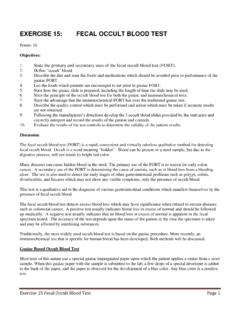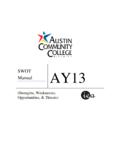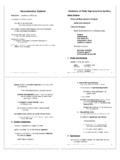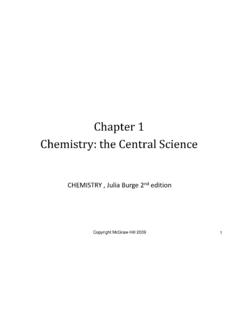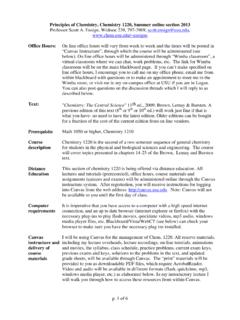Transcription of Sample Exercise 1.1 Distinguishing Among Elements ...
1 Copyright 2009 by Pearson Education, Saddle River, New Jersey 07458 All rights : The central Science, Eleventh EditionBy Theodore E. Brown, H. Eugene LeMay, Bruce E. Bursten, and Catherine J. MurphyWith contributions from Patrick WoodwardSample Exercise Distinguishing Among Elements , Compounds, and Mixtures White gold, used in jewelry, contains gold and another white metal such as palladium. Two different samples of white gold differ in the relative amounts of gold and palladium that they contain. Both samples are uniform in composition throughout. Without knowing any more about the materials, use Figure to classify white is composed of carbon, hydrogen, and oxygen by mass, regardless of its source.
2 Use Figure to characterize and classify : It is a compound because it has constant composition and can be separated into several ExerciseSolutionBecause the material is uniform throughout, it is homogeneous. Because its composition differs for the two samples, it cannot be a compound. Instead, it must be a homogeneous 2009 by Pearson Education, Saddle River, New Jersey 07458 All rights : The central Science, Eleventh EditionBy Theodore E. Brown, H. Eugene LeMay, Bruce E. Bursten, and Catherine J. MurphyWith contributions from Patrick WoodwardSample Exercise Using Metric PrefixesWhat is the name given to the unit that equals (a) 10-9gram, (b) 10-6second, (c) 10-3meter?
3 (a)What decimal fraction of a second is a picosecond, ps? (b) Express the measurement 103m using a prefix to replace the power of ten. (c) Use exponential notation to express mg in : (a) 10-12second, (b) km, (c) 10 3gPractice ExerciseSolutionIn each case we can refer to Table , finding the prefix related to each of the decimal fractions: (a) nanogram, ng, (b) microsecond, s, (c) millimeter, 2009 by Pearson Education, Saddle River, New Jersey 07458 All rights : The central Science, Eleventh EditionBy Theodore E. Brown, H. Eugene LeMay, Bruce E.
4 Bursten, and Catherine J. MurphyWith contributions from Patrick WoodwardSample Exercise Converting Units of TemperatureIf a weather forecaster predicts that the temperature for the day will reach 31 C, what is the predictedtemperature (a) in K, (b) in F?Ethylene glycol, the major ingredient in antifreeze, freezes at F . What is the freezing point in (a) K, (b) F?Answer: (a) K, (b) FPractice ExerciseSolutionCopyright 2009 by Pearson Education, Saddle River, New Jersey 07458 All rights : The central Science, Eleventh EditionBy Theodore E. Brown, H.
5 Eugene LeMay, Bruce E. Bursten, and Catherine J. MurphyWith contributions from Patrick Woodward(a)Calculate the density of mercury if 102 g occupies a volume of cm3. (b)Calculate the volumeof g of the liquid methanol (wood alcohol) if its density is g/mL. (c)What is the mass in grams ofa cube of gold (density = g/cm3) if the length of the cube is cm?(a) Calculate the density of a Sample of copper if it has a volume of cm3. (b) A student g of ethanol for an experiment. If the density of ethanol is g/mL, how many milliliters of ethanolare needed?
6 (c) What is the mass, in grams, of mL of mercury (density = g/mL)?Answers:(a) g/cm3, (b) mL, (c) 340 gPractice ExerciseSample Exercise Determining Density and Using Density to Determine Volume or MassSolution(a) We are given mass and volume, so Equation yields (b)Solving Equation for volume and then using the given mass and density gives (c) We can calculate the mass from the volume of the cube and its density. The volume of a cube is given by its length cubed: Solving Equation for mass and substituting the volume and density of the cube, we have Copyright 2009 by Pearson Education, Saddle River, New Jersey 07458 All rights : The central Science, Eleventh EditionBy Theodore E.
7 Brown, H. Eugene LeMay, Bruce E. Bursten, and Catherine J. MurphyWith contributions from Patrick WoodwardSample Exercise Relating Significant Figures to the Uncertainty of a MeasurementWhat difference exists between the measured values g and g?A balance has a precision of g. A Sample that has a mass of about 25 g is placed on this balance. Howmany significant figures should be reported for this measurement?Answer: five, as in the measurement g, the uncertainty being in the third decimal placePractice ExerciseSolutionMany people would say there is no difference, but a scientist would note the difference in the number of significant figures in the two measurements.
8 The value has two significant figures, while has three. This difference implies that the first measurement has more uncertainty. Amass of g indicates that the uncertainty is in the first decimal place of the measurement. Thus, the mass might be anything between and g, which we can represent as g. A measurement of g implies that the uncertainty is in the second decimal place. Thus, the mass might be anything between and g, which we can represent as g. Without further information, we cannot be sure whether the difference in uncertainties of the two measurements reflects the precision or accuracy of the 2009 by Pearson Education, Saddle River, New Jersey 07458 All rights : The central Science, Eleventh EditionBy Theodore E.
9 Brown, H. Eugene LeMay, Bruce E. Bursten, and Catherine J. MurphyWith contributions from Patrick WoodwardSample Exercise Determining the Number of Significant Figures in a MeasurementHow many significant figures are in each of the following numbers (assume that eachnumber is a measured quantity): (a) , (b) 1023, (c) 5000?How many significant figures are in each of the following measurements: (a) g, (b) 104cm, (c) m3?Answer: (a) four, (b) two, (c) threePractice ExerciseSolution(a) Four; the zeros are significant figures. (b) Four; the exponential term does not add to the number of significant figures.
10 (c) One. We assume that the zeros are not significant when there is no decimal point shown. If the number has more significant figures, a decimal point should be employed or the number written in exponential notation. Thus, 5000. has four significant figures, whereas 103has 2009 by Pearson Education, Saddle River, New Jersey 07458 All rights : The central Science, Eleventh EditionBy Theodore E. Brown, H. Eugene LeMay, Bruce E. Bursten, and Catherine J. MurphyWith contributions from Patrick WoodwardSample Exercise Determining the Number of Significant figures in a Calculated QuantityThe width, length, and height of a small box are cm, cm, and cm, respectively.


